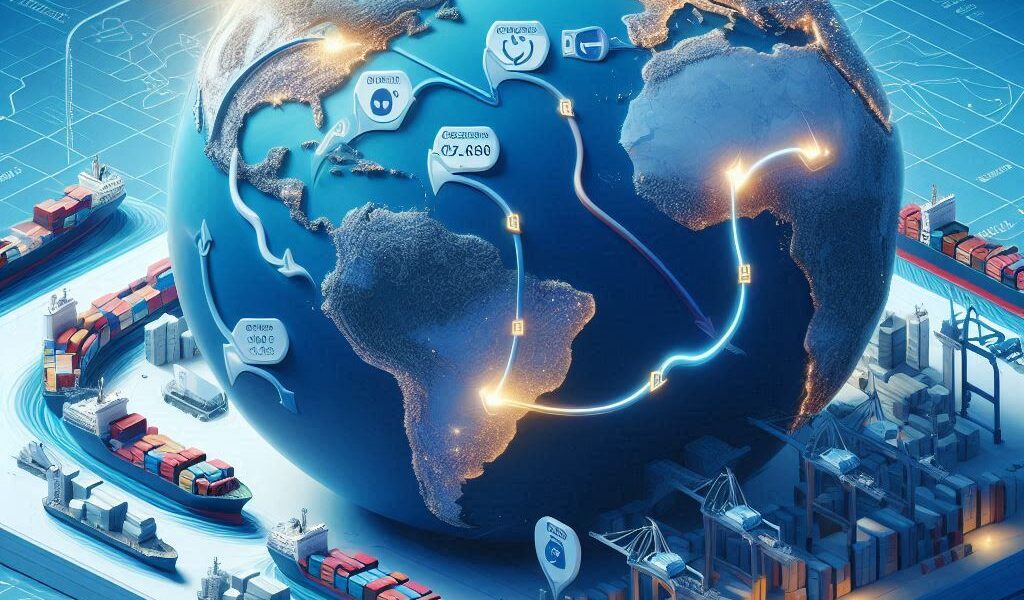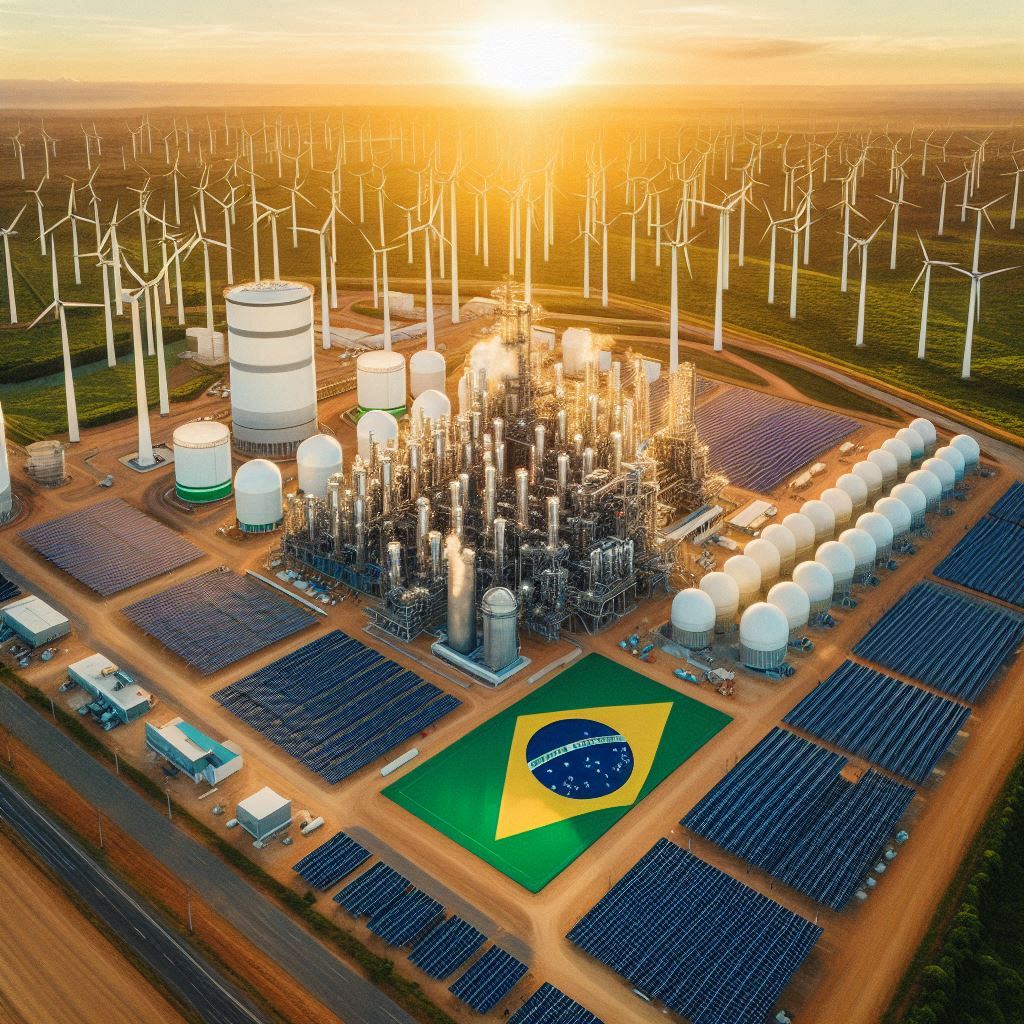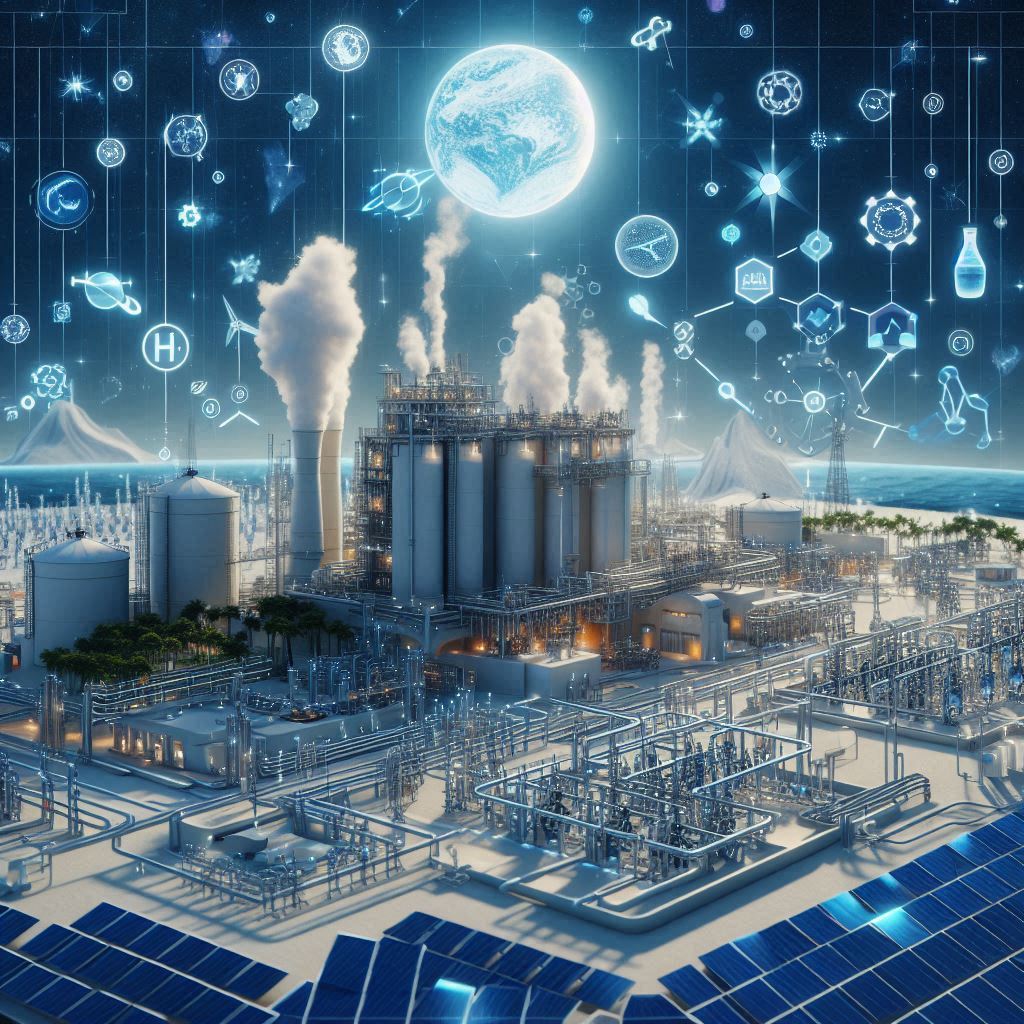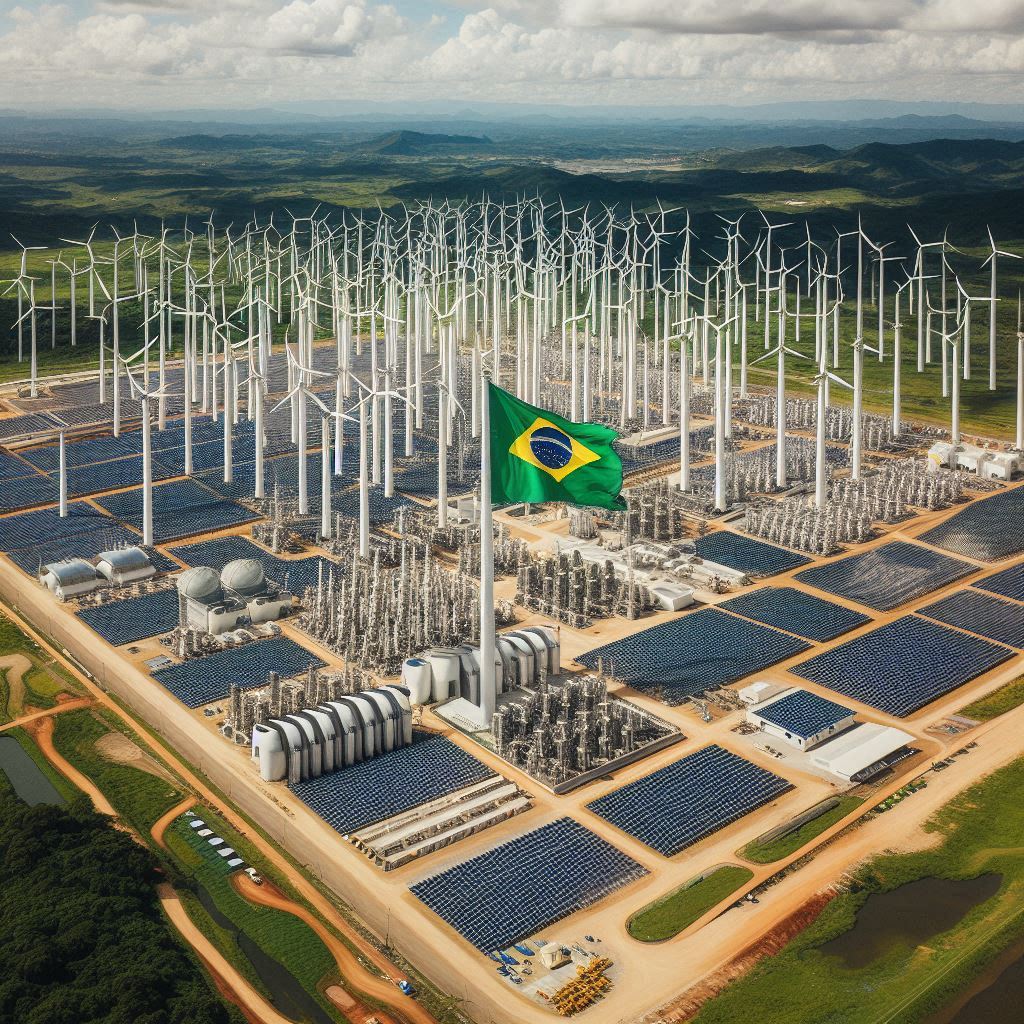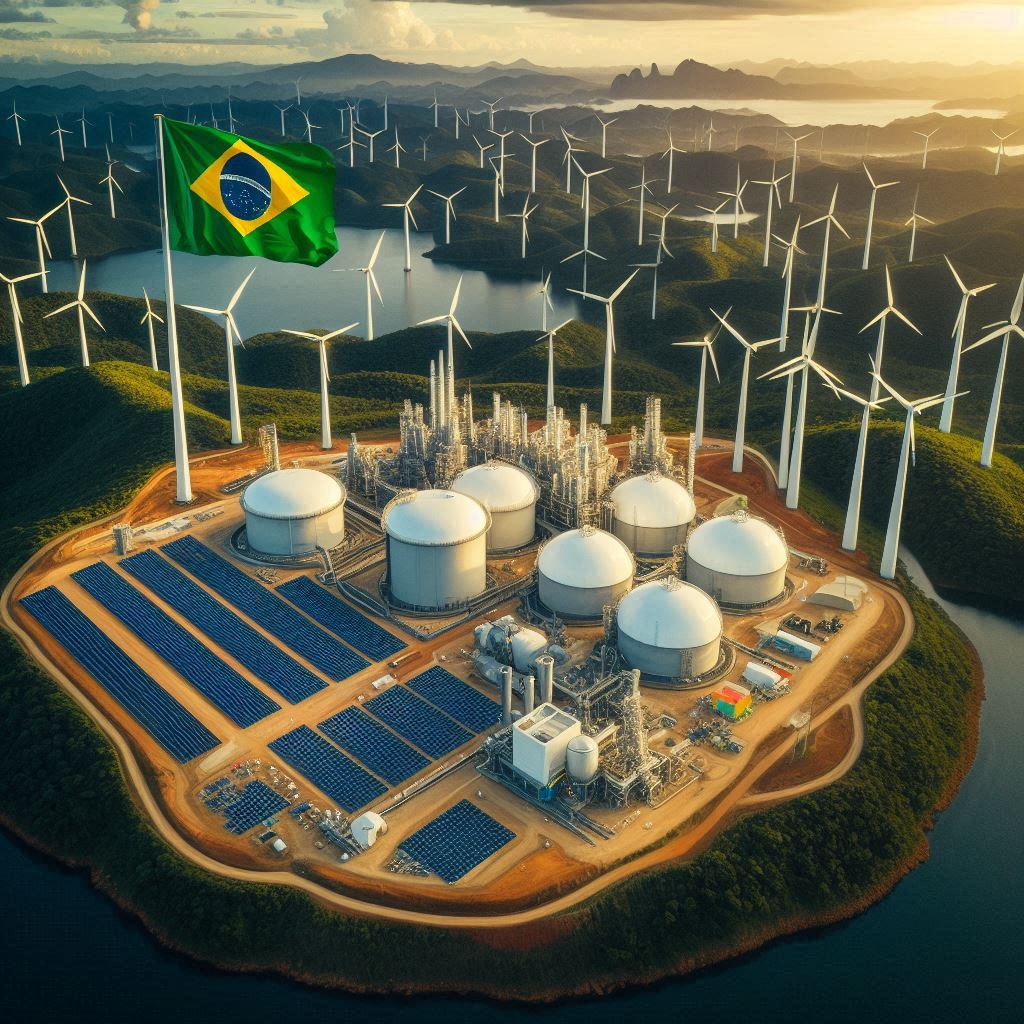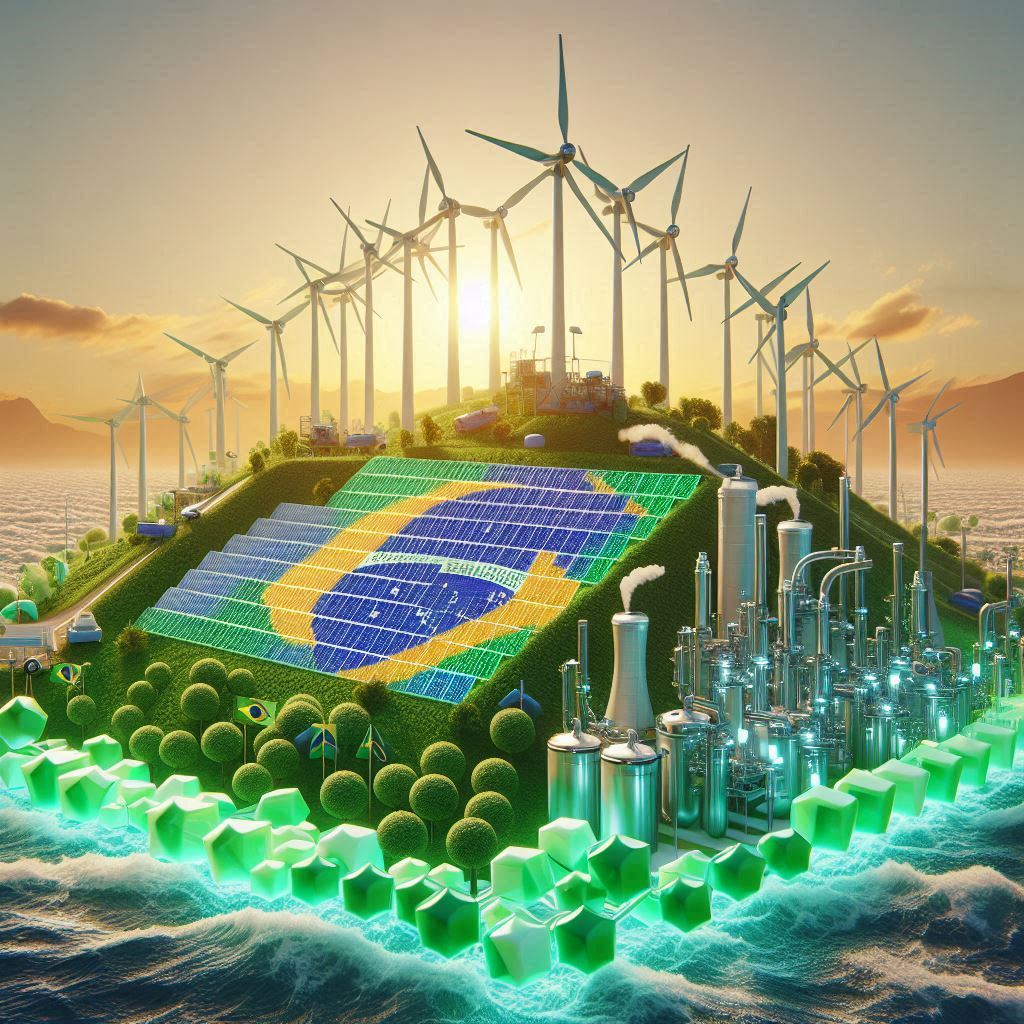Contents
- 1 Harnessing Solar and Wind for a Sustainable Future
- 2 Prof. Aécio D’Silva, Ph.D AquaUniversity
- 3
- 4 Green Hydrogen Revolution – The Power of the Northeast
- 5 Green Hydrogen Revolution: The Future of Clean Fuel
- 6 Strategic Partnerships and Investments
- 7
- 8 Green Hydrogen Revolution – The Role of Pernambuco, Ceará and Piaui
- 9 Green Hydrogen Revolution – Economic and Environmental Benefits
- 10 Infrastructure and Logistics
- 11 Green Hydrogen Revolution – A Promising Future
- 12
- 13 World Bank’s Green Hydrogen partnership with a consortium of Brazil’s nine northeastern states
- 14 How will the World Bank partnership enhance community engagement in renewable energy projects?
- 15
- 16 What specific financial mechanisms will the World Bank provide for low-carbon hydrogen projects?
- 17 How will the collaboration between BNDES and the World Bank reduce financing costs for low-carbon hydrogen projects?
- 18 Green Hydrogen Revolution – What are the expected job creation outcomes from this initiative
- 19
- 20 What role will small and medium enterprises play in job creation under this plan?
- 21 How will the partnership contribute to the preservation of the Caatinga ecosystem?
- 22 How does the climate of Northeast Brazil contribute to its green hydrogen potential?
- 23 What are the main advantages of Northeast Brazil’s climate for green hydrogen production?
- 24 How does the proximity of Northeast Brazil to Europe and North America impact its green hydrogen export potential?
- 25 What are the economic benefits of green hydrogen production for local communities in Northeast Brazil?
- 26 What partnerships are being formed between Brazil and European countries to support green hydrogen exports
- 27 Which European countries are leading the investment in Brazilian green hydrogen projects
- 28 How will the green hydrogen from Brazil be transported to Europe
- 29 What are the main transportation methods for green hydrogen from Brazil to Europe
- 30
- 31 What are the most promising transportation routes for green hydrogen from Brazil to Europe?
- 32 How will the Pernambuco Green Hydrogen Plant impact the local economy
- 33
- 34 How many new jobs will the Pernambuco Green Hydrogen Plant create
Harnessing Solar and Wind for a Sustainable Future
Prof. Aécio D’Silva, Ph.D
AquaUniversity
Green Hydrogen Revolution – Brazil is on the brink of a green energy revolution, with its Northeast region at the forefront. This area, rich in solar and wind resources, is poised to become a global leader in green hydrogen production. Join us as we explore how Brazil is transforming its natural advantages into a sustainable future.
Green Hydrogen Revolution – The Power of the Northeast
The Brazilian Northeast is a powerhouse of renewable energy. This region produces 68% of the country’s solar and wind energy, making it a prime location for green hydrogen projects. The combination of abundant sunshine and strong winds provides an ideal environment for generating clean energy.
Green Hydrogen Revolution: The Future of Clean Fuel
Green hydrogen is produced by using renewable energy to split water into hydrogen and oxygen, emitting zero greenhouse gases. This clean fuel is crucial for industries like aviation and steel, which are seeking sustainable alternatives. Brazil’s Northeast is well-positioned to lead in this field, thanks to its renewable energy capacity.
Strategic Partnerships and Investments
The World Bank has partnered with a consortium of Brazil’s northeastern states to promote low-carbon hydrogen production and solar energy development. This collaboration aims to create financial mechanisms and explore opportunities for green hydrogen projects, boosting the region’s potential.
Green Hydrogen Revolution – The Role of Pernambuco, Ceará and Piaui
Pernambuco, Ceará, and Piaui, states in Brazil’s Northeast, are set to be leaders in green hydrogen Production. Ceará is already prepared to host the world’s largest green hydrogen plant at the Port of Pecém. This ambitious project, in collaboration with Enegix Energy, will produce over 600,000 tons of green hydrogen annually, leveraging 3.4 GW of wind and solar power.
Green Hydrogen Revolution – Economic and Environmental Benefits
Investments in green hydrogen are not only environmentally beneficial but also economically advantageous. Brazil’s export processing zones offer tax incentives for green hydrogen production, making it a financially attractive option for companies. This strategy is vital for Brazil’s goal to become a green hydrogen powerhouse.
Brazil has many green hydrogen plants in development, including research and development projects, pilot projects, and larger plants:
- Neoenergia
A green hydrogen plant under construction in Brasilia that will be powered by a 150kWp photovoltaic plant. The plant is expected to launch in 2024 and will be one of the first green hydrogen supply points in the country for buses and light vehicles.
- EDP
A molecular hydrogen production facility launched in Ceará in January 2023 uses electricity from Brazil’s integrated grid. The $8.4 million pilot project was supported by the federal and state governments.
- White Martins
A plant in Pernambuco that began producing green hydrogen on an industrial scale in 2022. The plant is expected to start up in 2025 and will supply green hydrogen to glass manufacturer Cebrace and other industrial sectors.
- Base One
A 500 hectare Singaporean/Australian company Energix Energy plant at the Port of Pecém, in the state of Ceara, that is designed to produce over 600,000 tons of green hydrogen annually. The intended US$5.4-billion plant’s location near industrial hubs and export facilities highlights Brazil’s potential to become a major global supplier of green hydrogen when it opens in 2025.
- Green Energy Park Piauí
A 10.8GW green hydrogen and ammonia complex in Piauí is expected to produce its first green hydrogen and ammonia in 2028 and be fully completed in 2035. The project has secured long-term rights to hydrogen port terminal facilities in Luis Correia and has received funding from the EU.
Infrastructure and Logistics
Strategic locations across Brazil’s Northeast, with their renewable energy sources and logistical advantages, are ideal for green hydrogen projects. These sites are selected based on market demand, technical feasibility, and regulatory conditions, ensuring successful implementation.
Green Hydrogen Revolution – A Promising Future
The global shift towards clean energy is inevitable, and Brazil is at the forefront. By 2050, hydrogen is expected to account for 18% of global energy consumption, drastically reducing carbon emissions. Brazil’s commitment to green hydrogen positions it as a leader in this transition.
World Bank’s Green Hydrogen partnership with a consortium of Brazil’s nine northeastern states
It’s of strategic significance the participation of The World Bank’s partnership with a consortium of Brazil’s nine northeastern states to promote the development of the Northeast region for solar power generation and low-carbon hydrogen production.
The partnership between the World Bank and a consortium of Brazil’s nine northeastern states is also crucial for the development of the region’s solar power generation and low-carbon hydrogen production. This collaboration aims to leverage the Northeast’s abundant renewable resources to promote clean energy projects, including green hydrogen and solar power, which are vital for the energy transition.
The partnership focuses on developing financial mechanisms for low-carbon hydrogen projects and exploring opportunities for solar energy and water and sanitation projects. It also emphasizes the exchange of experiences and knowledge, which is essential for building digital public infrastructure and enhancing community engagement in the region.
The memorandum of understanding (MoU) signed between the World Bank and the Interstate Consortium for the Sustainable Development of the Northeast reflects a commitment to cooperate in key areas such as energy transition, community engagement, preservation of the Caatinga, and digital development. This partnership is expected to strengthen public policies already developed by the past and current Brazilian government and contribute to energy security, job creation, and the decarbonization of industry and transport.
Overall, the World Bank’s involvement is pivotal in providing expertise and facilitating the exchange of experiences between states, ensuring the sustainable development of the region. This collaboration positions Brazil’s Northeast as a leader in the global energy transition, with the potential to become a major producer of green hydrogen.
How will the World Bank partnership enhance community engagement in renewable energy projects?
The partnership between the World Bank and Brazil’s nine northeastern states is set to significantly enhance community engagement in renewable energy projects. This collaboration aims to promote clean hydrogen and solar power generation while focusing on community involvement as a key component of the development strategy.
The partnership will enhance community engagement through several means:
- Exchange of Experiences and Knowledge: By facilitating the exchange of experiences and knowledge, the partnership will empower local communities with the skills and understanding needed to actively participate in renewable energy projects. This exchange will help build local capacity and ensure that communities are well informed about the benefits and opportunities associated with renewable energy initiatives.
- Development of Digital Public Infrastructure: The partnership includes a focus on financing digital public infrastructure, which can improve communication and engagement with local communities. By enhancing digital connectivity, communities can have better access to information and participate more effectively in decision-making processes related to renewable energy projects.
- Community Engagement as a Priority: The memorandum of understanding (MoU) explicitly mentions community engagement as one of the four key areas of focus. This indicates a commitment to involving local populations in the planning and implementation of renewable energy projects, ensuring that their needs and perspectives are considered.
- Benefit Sharing and Risk Management: The partnership is likely to incorporate strategies for benefit sharing and risk management, which are essential for gaining community support and trust. By ensuring that communities receive tangible benefits from renewable energy projects, such as job creation and improved infrastructure, the partnership can foster a sense of ownership and participation among local residents.
Overall, the World Bank’s partnership with Brazil’s northeastern states is designed not only to advance renewable energy development but also to actively involve communities in the process actively, thereby enhancing the sustainability and success of these projects.
What specific financial mechanisms will the World Bank provide for low-carbon hydrogen projects?
The World Bank provides several specific financial mechanisms to support low-carbon hydrogen projects, focusing on making clean hydrogen commercially competitive and reducing production and financing costs. Here are the key mechanisms:
- Co-Financing Initiatives: The World Bank, in collaboration with the Brazilian Development Bank (BNDES), is endorsing co-financing initiatives that include guarantees, technical assistance financing, and establishing credit lines facilitated by participating banks. These financial instruments are designed to act as catalysts for projects driving the low-carbon hydrogen agenda.
- De-Risking Projects: The World Bank is designing financing mechanisms to de-risk hydrogen projects, which is essential for reducing perceived risks and attracting investment. This includes addressing uncertainties about eventual buyers, pre-agreed prices, and political and regulatory unpredictability.
- Capacity Building and Knowledge Sharing: The partnership involves capacity building and knowledge sharing through digital hubs and matchmaking platforms. These tools encourage the adoption of clean hydrogen projects by providing technical assistance and fostering international coordination and consensus on standards and markets.
- Support for Infrastructure and Logistics: The World Bank’s initiatives cover projects related to carbon capture, electrolyzers, associated equipment, and infrastructure hubs dedicated to advancing hydrogen technology. This comprehensive approach supports the entire low-carbon hydrogen value chain.
- Scaling Hydrogen Financing for Development: The World Bank’s action plan includes a 10 GW clean hydrogen initiative, which aims to demonstrate the viability of clean hydrogen projects across emerging markets and reduce financing costs. This initiative is part of a broader effort to create scalable solutions and boost adoption rates.
These financial mechanisms are integral to advancing low-carbon hydrogen projects by addressing economic viability gaps, fostering international collaboration, and promoting sustainable energy solutions.
How will the collaboration between BNDES and the World Bank reduce financing costs for low-carbon hydrogen projects?
The collaboration between BNDES and the World Bank is designed to reduce financing costs for low-carbon hydrogen projects through several strategic financial mechanisms:
- Co-Financing Initiatives: The partnership endorses co-financing initiatives, which include guarantees, technical assistance financing, and the establishment of a credit line facilitated by participating banks. These financial instruments are intended to act as catalysts for projects, making them more financially viable and attractive to investors by sharing and mitigating risks.
- Development of a Credit Line: By developing a dedicated line of credit for low-carbon hydrogen projects, the collaboration aims to provide easier access to funding. This can lower the cost of capital for project developers and encourage the initiation and expansion of hydrogen projects.
- Risk Mitigation: The provision of guarantees helps in reducing the perceived risks associated with investing in innovative low-carbon technologies. This can lead to lower interest rates and better financing terms, thus reducing overall project costs.
- Technical Assistance: By offering technical assistance financing, the partnership aims to enhance project design and implementation, which can lead to more efficient and cost-effective project outcomes. This support can also help in overcoming technical and regulatory barriers, further reducing costs.
- Knowledge Exchange: The partnership prioritizes knowledge exchange as a tool for stimulating investments. By leveraging the combined expertise of BNDES and the World Bank, the collaboration can improve project planning and execution, potentially leading to cost savings and increased project success rates.
Overall, these mechanisms are designed to make low-carbon hydrogen projects more financially accessible and attractive, thereby accelerating their development and contributing to Brazil’s energy transition goals.
Green Hydrogen Revolution – What are the expected job creation outcomes from this initiative
The collaboration between the World Bank and Brazil’s northeastern states is expected to create significant job opportunities as part of the broader strategy to enhance productivity and promote a greener economy. Here are the expected job creation outcomes from this initiative:
- Expansion of Renewable Energy Projects: By promoting solar power generation and low-carbon hydrogen production, the initiative is likely to create jobs in the construction, operation, and maintenance of renewable energy facilities. This includes roles in engineering, project management, and technical support.
- Development of Infrastructure: The focus on modern infrastructure development, particularly in digital, transportation, and logistics, will generate employment opportunities in the construction, technology, and logistics sectors.
- Support for Micro, Small, and Medium Enterprises (MSMEs): The strategy includes mobilizing capital and supporting MSMEs, particularly in the Amazon region, which can lead to job creation in various sectors, including agriculture, manufacturing, and services.
- Capacity Building and Training: As the initiative emphasizes capacity building, it will create jobs in the education and training sectors to equip the workforce with the necessary skills for the renewable energy and green technology industries.
- Sustainable Development Projects: The partnership aims to support sustainable development projects, such as those focused on reducing emissions and improving resource management. These projects will create jobs in environmental management, research, and policy development.
Overall, the partnership is designed to foster economic growth and job creation by leveraging Brazil’s renewable energy potential and promoting sustainable development across various sectors. This approach aligns with the World Bank’s goal of building a more productive, inclusive, and greener economy in Brazil.
What role will small and medium enterprises play in job creation under this plan?
Small and medium enterprises (SMEs) are expected to play a pivotal role in job creation under the plan to develop Brazil’s Northeast region for solar power generation and low-carbon hydrogen production. Here are the key aspects of their involvement:
- Major Contributors to Employment: SMEs are a significant driver of job creation in Brazil, accounting for 62% of total employment. They are particularly effective in generating jobs due to their labor-intensive nature, which contrasts with larger companies that often focus on automating processes.
- Support for Local Economies: By participating in renewable energy projects, SMEs can stimulate local economies, providing jobs in various sectors such as construction, manufacturing, and services. This is particularly important in the Northeast region, where SMEs can leverage the abundant renewable resources to create sustainable business opportunities.
- Implementation of Renewable Projects: SMEs are likely to be involved in the implementation and maintenance of renewable energy projects. Their flexibility and adaptability make them well-suited to handle various aspects of project development, from installation to ongoing operations.
- Government Support and Incentives: The Brazilian government has implemented policies to support SMEs, such as the “Simples Nacional” tax regime, which simplifies tax obligations and reduces administrative burdens. This support helps SMEs thrive and expand, thereby increasing their capacity to create jobs.
- Innovation and Entrepreneurship: SMEs are encouraged to engage in innovation and entrepreneurship, which can lead to the development of new technologies and business models in the renewable energy sector. This can further enhance job creation by opening up new markets and opportunities.
Overall, the involvement of SMEs in renewable energy projects in Brazil’s Northeast is expected to significantly boost job creation, supporting both local economies and the broader national goal of transitioning to a sustainable energy future.
How will the partnership contribute to the preservation of the Caatinga ecosystem?
The partnership between the World Bank and Brazil’s northeastern states is expected to significantly contribute to the preservation of the Caatinga ecosystem. This collaboration aims to promote sustainable development and environmental conservation in the region. Here are the ways in which the partnership will aid in preserving the Caatinga:
- Biodiversity Conservation: The World Bank’s involvement in projects like the Caatinga Conservation and Management Project focuses on preserving and managing the biodiversity of the Caatinga ecosystem. This includes efforts to protect native species and their habitats, which are crucial for maintaining ecological balance.
- Sustainable Management Practices: The partnership emphasizes sustainable management practices that align with the conservation goals of the Caatinga. This involves implementing strategies that ensure the sustainable use of natural resources, thereby reducing the environmental impact and promoting ecological resilience.
- Community Engagement and Education: By engaging local communities and promoting education about the importance of the Caatinga, the partnership aims to foster a sense of stewardship and responsibility. This approach encourages communities to participate actively in conservation efforts and adopt sustainable practices.
- Integration with Renewable Energy Projects: The focus on renewable energy projects, such as solar power generation and low-carbon hydrogen production, is designed to provide economic alternatives that do not compromise the integrity of the Caatinga ecosystem. This integration helps reduce reliance on practices that may harm the environment.
Overall, the partnership’s comprehensive approach to conservation, sustainable management, and community involvement is expected to create a positive impact on the preservation of the Caatinga ecosystem.
How does the climate of Northeast Brazil contribute to its green hydrogen potential?
The climate of Northeast Brazil significantly contributes to its potential for green hydrogen production due to several key factors:
- Abundant Solar and Wind Resources: Northeast Brazil is endowed with reliable and consistent winds, as well as sunshine throughout much of the year. These climatic conditions are ideal for generating the renewable energy needed for green hydrogen production through electrolysis, a process that requires substantial amounts of electricity to split water into hydrogen and oxygen.
- High Renewable Energy Penetration: The region has seen a substantial increase in the share of renewables in its energy matrix, with wind and solar energy contributing significantly. This high penetration of renewable energy sources supports the production of green hydrogen, which relies on clean energy inputs to ensure the process is environmentally sustainable.
- Geographic Advantages: The proximity of Northeast Brazil to Europe and North America offers strategic and logistical advantages for exporting green hydrogen. This geographic positioning, combined with the region’s renewable energy capacity, makes it a competitive player in the global green hydrogen market.
- Existing Infrastructure and Projects: The region is already home to several sanctioned and planned projects focused on green hydrogen production. The presence of ports and industrial complexes, such as the Port and Industrial Complex of Pecém in Ceará, facilitates the development and scaling of green hydrogen initiatives.
Overall, the climate and geographic features of Northeast Brazil provide a strong foundation for the region to become a leader in green hydrogen production, leveraging its natural resources to meet both domestic and international energy demands.
What are the main advantages of Northeast Brazil’s climate for green hydrogen production?
Northeast Brazil’s climate offers several advantages for green hydrogen production, making it an ideal location for this emerging industry:
- Consistent Wind and Solar Resources: The region is blessed with reliable and consistent winds, along with sunshine for the majority of the year. These conditions are perfect for generating the renewable energy needed for green hydrogen production through electrolysis, which requires substantial electricity to split water into hydrogen and oxygen.
- High Penetration of Renewables: The Northeast has a significant share of Brazil’s renewable energy capacity, with wind and solar energy contributing substantially to the energy mix. This high penetration of renewables supports the production of green hydrogen, which relies on clean energy inputs to ensure the process is environmentally sustainable.
- Geographic and Logistical Advantages: The proximity of Northeast Brazil to major markets in Europe and North America offers strategic and logistical benefits for exporting green hydrogen. This geographic positioning, combined with the region’s renewable energy capacity, makes it a competitive player in the global green hydrogen market.
- Existing Infrastructure and Projects: The region is home to several sanctioned and planned green hydrogen projects, such as the Port and Industrial Complex of Pecém in Ceará. This existing infrastructure facilitates the development and scaling of green hydrogen initiatives.
Overall, the climate and geographic features of Northeast Brazil provide a strong foundation for the region to become a leader in green hydrogen production, leveraging its natural resources to meet both domestic and international energy demands.
How does the proximity of Northeast Brazil to Europe and North America impact its green hydrogen export potential?
The proximity of Northeast Brazil to Europe and North America significantly enhances its potential as a green hydrogen exporter due to several strategic and logistical advantages:
- Cost-Effective Shipping: The geographic location of Northeast Brazil allows for relatively cost-effective shipping routes to Europe and North America. A study by the Fraunhofer Institute for Solar Energy Systems ISE found that shipping liquid green hydrogen from the state of Rio Grande do Norte to Europe could cost €5.71/kg, making it cheaper than other countries in the study, including Colombia. This cost advantage is crucial for competitive pricing in international markets.
- Strategic Export Position: Northeast Brazil’s proximity to major markets in Europe and North America positions it strategically for exporting green hydrogen. This geographic advantage reduces transportation times and costs, making Brazilian green hydrogen more attractive to these regions, which are actively seeking to decarbonize their energy and industrial sectors.
- Infrastructure and Port Facilities: The region’s ports, such as the Port and Industrial Complex of Pecém in Ceará, are being developed as major green hydrogen production and export hubs. These facilities are well-equipped to handle large-scale exports, further enhancing Brazil’s ability to supply green hydrogen to international markets efficiently.
- International Partnerships and Alliances: Brazil has established partnerships with European countries, such as Germany and the Netherlands, to promote the green hydrogen market. These alliances facilitate market access and create opportunities for joint ventures and investments, strengthening Brazil’s export potential.
- Growing Global Demand: Europe, in particular, is expected to import a significant portion of its green hydrogen needs, with Brazil being well-positioned to meet this demand. The European Union’s commitment to reducing carbon emissions and transitioning to clean energy sources aligns with Brazil’s green hydrogen capabilities.
Overall, the proximity of Northeast Brazil to key international markets, combined with its renewable energy resources and strategic infrastructure, positions it as a competitive player in the global green hydrogen market.
What are the economic benefits of green hydrogen production for local communities in Northeast Brazil?
Green hydrogen production in Northeast Brazil offers substantial economic benefits for local communities, driven by the region’s abundant renewable resources and strategic initiatives. Here are the key economic advantages:
- Job Creation: The development of the green hydrogen industry is expected to generate significant employment opportunities. The European Commission estimates that every billion dollars invested in green hydrogen can create approximately 20,000 jobs along the supply chain, including production, transmission, storage, and utilization. This job creation is crucial for local economies, providing new opportunities in various sectors such as construction, engineering, and maintenance.
- Economic Growth: Green hydrogen production can drive economic growth by attracting investments and fostering industrial development. The initiative is projected to generate USD 15-20 billion in revenues by 2040, with a substantial portion serving the domestic market, particularly in energy-intensive industries like trucking and steel production. This economic activity can stimulate local businesses and increase regional GDP.
- Infrastructure Development: Investments in green hydrogen projects often lead to the development of necessary infrastructure, such as renewable energy facilities and transportation networks. This infrastructure not only supports hydrogen production but also benefits local communities by improving access to energy and enhancing overall connectivity.
- Export Opportunities: The proximity of Northeast Brazil to major markets in Europe and North America positions it as a competitive exporter of green hydrogen and its derivatives. This export potential can bring additional revenue to local economies and strengthen Brazil’s position in the global energy market.
- Sustainable Development: By focusing on renewable energy and green hydrogen, the region can achieve sustainable development goals, reducing reliance on fossil fuels and decreasing greenhouse gas emissions. This transition supports environmental conservation and promotes a healthier ecosystem, benefiting local communities in the long term.
Overall, the economic benefits of green hydrogen production in Northeast Brazil are significant, offering job creation, economic growth, infrastructure development, export opportunities, and sustainable development for local communities.
What partnerships are being formed between Brazil and European countries to support green hydrogen exports
Several partnerships are being formed between Brazil and European countries to support the export of green hydrogen, highlighting the strategic collaboration in this emerging sector:
- EU Funding for Brazilian Projects: The European Union has pledged funding from a €2 billion pot for a 10GW green hydrogen and ammonia complex in Brazil. This project aims to export ammonia produced in Brazil to a terminal in Croatia, showcasing the EU’s commitment to supporting Brazil’s green hydrogen initiatives.
- Germany-Brazil Collaboration: Germany and Brazil are working together to shape the green hydrogen market, focusing on decarbonizing heavy industries and establishing a global market for green hydrogen. This partnership is part of broader efforts to enhance renewable energy production and utilization.
- EU-Brazil Green Energy Transition: The EU and Brazil are engaged in a partnership aimed at reinforcing their green energy collaboration. This includes strategic initiatives under the EU’s Green Deal Industrial Plan and the Global Gateway strategy, which focus on diversifying access to critical inputs and fostering sustainable trade and investments in the green energy sector.
- Hydrogen Expo and Brazil-Germany Chamber of Commerce: Events like the Hydrogen Expo, organized by the Brazil-Germany Chamber of Commerce and Industry, facilitate discussions and collaborations between Brazil and European stakeholders. These events emphasize Brazil’s competitive position as a green hydrogen exporter to the EU.
These partnerships underscore the mutual interest in developing a robust green hydrogen market, leveraging Brazil’s abundant renewable resources and Europe’s demand for clean energy solutions.
Which European countries are leading the investment in Brazilian green hydrogen projects
The European Union (EU) is the primary entity leading investment in Brazilian green hydrogen projects. The EU has pledged to invest €2 billion (approximately USD 2.2 billion) in a 10 GW green hydrogen and ammonia project in Brazil. This substantial investment is part of the EU’s Global Gateway initiative, which aims to support the hydrogen value chain in Brazil. The project will be located in the northeastern state of Piauí and will involve the construction of a facility to produce green hydrogen and ammonia for export, particularly to Europe. The facility’s output is planned to be shipped to the island of Krk in Croatia and then supplied to industrial off-takers in Southeast Europe, including industrial areas in Southern Germany and Northern Italy.
How will the green hydrogen from Brazil be transported to Europe
Green hydrogen from Brazil will be transported to Europe primarily in the form of ammonia. The process involves several key steps:
- Production and Conversion: Green hydrogen is produced in Brazil using renewable energy sources. To facilitate transportation, the hydrogen is converted into ammonia, which is easier and more cost-effective to transport over long distances.
- Shipping to Europe: The ammonia will be shipped from Brazil to a terminal on the island of Krk in Croatia. This location serves as a strategic entry point for distributing the ammonia to various industrial off-takers across Southeast Europe.
- Distribution and Utilization: Once the ammonia arrives in Europe, it can be used directly or converted back into hydrogen for use in various industrial applications, including low-carbon steel production and other decarbonization efforts.
This method of transporting green hydrogen as ammonia leverages existing infrastructure and shipping routes, making it a viable solution for exporting Brazil’s renewable energy to European markets.
What are the main transportation methods for green hydrogen from Brazil to Europe
The main transportation method for green hydrogen from Brazil to Europe involves converting the hydrogen into ammonia for easier and more cost-effective shipping. Here is how the process typically works:
- Conversion to Ammonia: Green hydrogen produced in Brazil is converted into ammonia. This conversion is necessary because ammonia is easier to transport over long distances compared to hydrogen gas, which requires more complex and costly handling due to its low energy density and storage challenges.
- Maritime Shipping: The ammonia is then shipped via maritime routes to Europe. Shipping ammonia is more economical and feasible for long-distance transport, especially when pipelines are not available or practical.
- Destination and Distribution: Upon arrival in Europe, the ammonia can be used directly in various industrial applications or converted back into hydrogen for specific uses. For instance, the ammonia from Brazil is planned to be shipped to a terminal on the island of Krk in Croatia, from where it will be distributed to industrial off-takers in Southeast Europe.
This method leverages existing shipping infrastructure and minimizes transportation costs, making it a practical solution for exporting Brazil’s green hydrogen to European markets.
Title: The main transportation method for green hydrogen from Brazil to Europe involves converting the hydrogen into ammonia for easier and more cost-effective shipping. Here is how the process typically works:
- Conversion to Ammonia: Green hydrogen produced in Brazil is converted into ammonia. This conversion is necessary because ammonia is easier to transport over long distances compared to hydrogen gas, which requires more complex and costly handling due to its low energy density and storage challenges.
- Maritime Shipping: The ammonia is then shipped via maritime routes to Europe. Shipping ammonia is more economical and feasible for long-distance transport, especially when pipelines are not available or practical.
- Destination and Distribution: Upon arrival in Europe, the ammonia can be used directly in various industrial applications or converted back into hydrogen for specific uses. For instance, the ammonia from Brazil is planned to be shipped to a terminal on the island of Krk in Croatia, from where it will be distributed to industrial off-takers in Southeast Europe.
This method leverages existing shipping infrastructure and minimizes transportation costs, making it a practical solution for exporting Brazil’s green hydrogen to European markets.
What are the most promising transportation routes for green hydrogen from Brazil to Europe?
The most promising transportation routes for green hydrogen from Brazil to Europe involve the use of strategic ports and shipping corridors that facilitate efficient export logistics. Here are the key routes and methods:
- The Port of Suape in Recife, Pernambuco, presents one of the most promising transportation routes for green hydrogen (in the form of ammonia) exports from Brazil to Europe. Here are the key factors that enhance its potential:
- Strategic Location and Infrastructure: Suape is the largest public port in Northeast Brazil and ranks among the country’s top ports in terms of cargo volume. Its strategic location near Recife provides easy access to international shipping routes, making it an ideal hub for exporting green hydrogen derivatives to Europe.
- Investment in Green Hydrogen Projects: The Port of Suape is set to receive significant investments for green hydrogen production. For instance, Qair Brasil plans to invest $3.8 billion in the Pernambuco Green Hydrogen Plant, which will include water electrolysis facilities to produce green hydrogen and its derivatives, such as ammonia. This project underscores the port’s capacity to support large-scale green hydrogen production and export.
- Partnerships and Agreements: Suape has formed partnerships with companies like Voltalia, which signed a Memorandum of Understanding with the Government of Pernambuco to collaborate on green hydrogen production and export projects. Voltalia’s involvement, with 1.4 GW of installed capacity in solar and wind plants, positions Suape as a competitive player in the green hydrogen market.
- Focus on Export and Industrial Development: The port aims to position itself as a hub for the production and export of green hydrogen and its derivatives. This focus aligns with Pernambuco’s strategy to attract investments related to the energy transition and develop new industrial chains, particularly those catering to European markets.
Overall, the Port of Suape’s strategic initiatives, infrastructure, and partnerships make it a viable and promising route for exporting green hydrogen to Europe, supporting Brazil’s role in the global energy transition.
- Pecém to Rotterdam Corridor: One of the primary transportation routes involves the green hydrogen corridor between Pecém Port in Brazil and the Port of Rotterdam in the Netherlands. This corridor has been officially launched as a partnership between the governments of Ceará State, Brazil, and the Netherlands. The route is designed to create a direct transportation link, making Rotterdam a central hub for distributing green hydrogen across Europe.
- Piauí’s Port Luis Correa to Croatia Route: Another significant route involves the export of green hydrogen produced in the northeastern state of Piauí. The hydrogen will be converted into ammonia and shipped to the island of Krk in Croatia. From there, it will be supplied to industrial off-takers in Southeast Europe. This route is part of a larger initiative supported by the European Union’s Global Gateway investment, which aims to enhance the hydrogen value chain between Brazil and Europe.
These transportation routes leverage Brazil’s strategic geographic position and existing port infrastructure to facilitate the export of green hydrogen to Europe, supporting the continent’s decarbonization goals.
How will the Pernambuco Green Hydrogen Plant impact the local economy
The Pernambuco Green Hydrogen Plant at the Port of Suape is expected to have several positive impacts on the local economy:
- Job Creation: The development of the plant is anticipated to generate a significant number of jobs. According to estimates, investments in green hydrogen can create approximately 20,000 jobs for every billion dollars invested along the supply chain, including production, transmission, storage, and utilization. This will provide employment opportunities in various sectors, such as construction, engineering, and operations.
- Economic Growth: The $3.8 billion investment in the Pernambuco Green Hydrogen Plant represents one of the largest in the state’s history. This substantial financial influx is expected to stimulate economic growth by attracting further investments and fostering industrial development in the region.
- Infrastructure Development: The project involves the installation of water electrolysers and other infrastructure necessary for green hydrogen production. This development will enhance the region’s industrial capabilities and support the establishment of new value chains, further boosting economic activity.
- Positioning as an Energy Hub: The Port of Suape aims to position itself as a hub for the production and export of green hydrogen and its derivatives. This strategic positioning is expected to attract additional investments and industries to the region, contributing to long-term economic sustainability.
- Environmental and Social Benefits: The production of green hydrogen using renewable energy sources will contribute to the decarbonization of the local economy, aligning with global sustainability goals. This transition to cleaner energy sources can also improve the quality of life for local communities by reducing pollution and promoting sustainable development.
Overall, the Pernambuco Green Hydrogen Plant is poised to significantly impact the local economy by creating jobs, stimulating growth, and positioning the region as a key player in the global green hydrogen market.
How many new jobs will the Pernambuco Green Hydrogen Plant create
The Pernambuco Green Hydrogen Plant at the Port of Suape is expected to create approximately 1,500 direct jobs during its construction phase. This figure reflects the significant employment opportunities associated with the development and implementation of this large-scale renewable energy project, which involves the installation of water electrolyzers and the establishment of infrastructure necessary for green hydrogen production and export.
Concluding, Brazil’s Northeast is transforming its abundant natural resources into a sustainable future through green hydrogen. With strategic investments, partnerships, and infrastructure, the region is set to lead the world in clean energy production. Keep an eye on Brazil as it turns sun power into clean fuel, paving the way for a greener tomorrow.
References:
- CAF. (2024). Green hydrogen: energy source for Brazilian northeast.
- Renewables Now. (2023). World Bank to help promote clean hydrogen, solar in Brazil’s Northeast.
- Wilson Center. (2021). Northeastern Brazil to Build World’s Biggest Green Hydrogen Plant.
[4] https://www.caf.com/en/knowledge/views/2024/02/green-hydrogen-energy-source-for-brazilian-northeast/
[5] https://renewablesnow.com/news/world-bank-to-help-promote-clean-hydrogen-solar-in-brazils-northeast-834966/
[6] https://www.wilsoncenter.org/blog-post/northeastern-brazil-build-worlds-biggest-green-hydrogen-plant
[7] https://www.pollutionsolutions-online.com/news/green-energy/42/eksfin/new-solar-power-plant-constructing-in-north-eastern-brazil/60182
[6] https://brazilenergyinsight.com/2021/06/03/port-of-suape-pe-to-receive-us-3-8-billion-in-investment-in-a-green-hydrogen-plant-from-qair-brasil/
[7] https://energycentral.com/c/cp/ctg-brazil-announces-green-hydrogen-hub-port-suape-partnership-senai-and
[8] https://www.datamarnews.com/noticias/voltalia-signs-agreement-for-green-hydrogen-project-at-the-port-of-suape/
